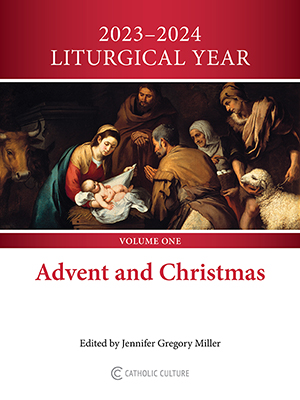Higher Thought from the Bay Area
By Diogenes ( articles ) | Feb 15, 2004
My local supermarket no longer displays Studies in the Spirituality of Jesuits in the check-out racks, so I was especially pleased to see it's now available on-line. The latest number features an essay by University of San Francisco artist Fr. Thomas Lucas, S.J., which expounds the value of visual imagery in Christian life, focusing on the cult and representation of Our Lady of Guadalupe. The little people, for centuries, have been awed by what they imagined to be a miraculous apparition at Tepeyac, but miracles soften and dissolve in the acid bath of Lucas's post-modern Gnosticism. Check out the following quote from psychiatrist William Meissner, S.J. ("Iñigo" is St. Ignatius Loyola, who recounts in his Autobiography a vision of the Virgin and Child he was given in 1521):
"We can conjecture, then, that the vision of Our Lady with the child Jesus was a reflection of Iñigo's idealized image of his own mother as well as that of [his sister-in-law] Magdalena, toward whom his unconscious libidinal impulses had been stirred. We might suggest as well that in his fantasy Iñigo saw himself as the baby Jesus, who could be cared for, loved by, and who in turn could possess his idealized mother. The wishful repression to a preoedipal state would avoid the destructive consequences of the potential oedipal conflict. Regression to a state of blissful union with the idealized mother also denies any incestuous longings that might carry the stamp of a more mature and differentiated sexuality."
And you thought the old boy was a mystic!
Distinguishing true Gnostics from their pop-culture counterfeits, Prof. James Hitchcock recently wrote: "Modern people like Dan Brown, who treat the Gnostic gospels as history, miss the point
In the end, it doesn't really matter to me if Juan Diego existed or not, or whether "roses, lilies, violets, carnation, jasmine, irises, rosemary and broom" arranged by a mysterious lady in a peasant's cloak became a miraculous sign. For some, the sign is empty without the miraculous origin. For me, as for Florencia three hundred years ago, the miraculous sign begins when you see people gather below her image.
Now isn't that cute? In the bad old days, it mattered to Catholics (and to their adversaries) whether people who claimed to be witnesses to supernatural events were lying or telling the truth. But that kind of discourse divides people into those who are right and those who are wrong. And those who are wrong need to change. If we can put history behind us once for all, then we can ... we can ... well, we can celebrate diversity!
On December 12th for the past four years, at dawn, an unlikely community forms: USF's Mexican cleaning ladies, janitors, and gardeners; high ranking administrators and professors, punked-out clerical workers and librarians, pierced and tattooed students, Jesuits, parishioners, neighbors, transvestites, gay people, straight people, strangers and friends. More come each year from all over the city, gather for a moment, enfolded in the same mantle, to experience the same sweetness. Maybe that is miracle enough.
All comments are moderated. To lighten our editing burden, only current donors are allowed to Sound Off. If you are a current donor, log in to see the comment form; otherwise please support our work, and Sound Off!








